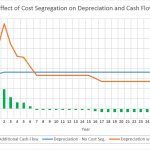Content

No matter which method you use to calculate depreciation, the entry to record accumulated depreciation includes a debit to depreciation expense and a credit to accumulated depreciation. Depreciation is expensed on the income statement for the current period as a non-cash item, meaning it’s an accounting entry to reflect the current accounting period’s value of the wear and tear of the asset. Depreciation is the accounting method that captures the reduction in value, and accumulated depreciation is the total amount of the depreciated asset at a specific point in time. These changes can affect the value of your business and your taxes. A liability is a future financial obligation (i.e. debt) that the company has to pay.
- Its value indicates how much of an asset’s worth has been utilized.
- It is here that depreciation expenses affect a company’s net income.
- The adjusting entry for a depreciation expense involves debiting depreciation expense and crediting accumulated depreciation.
- Since accelerated depreciation is an accounting method of charging depreciation on assets, the result of it is to book accumulated depreciation.
- You will then open the Depreciation Expense account , and enter a debit entry for $1,000.
- Accumulated depreciation is the total amount an asset has been depreciated up until a single point.
On the other hand, depreciation expense is used as a tax deduction to reduce taxable income. During the useful life of an asset, depreciation is marked as a debit while accumulated depreciation is marked as a credit. When the asset is then removed from the company, its accumulated depreciation will be labeled as a debit and the asset’s overall value as a credit.
What Heading Is the Capital Lease Reported Under on a Balance Sheet?
Under this method of depreciation, a company subtracts the salvage value also known as the scrap value or residual value from the cost or purchase price of the asset to find a depreciable base. This base is then accumulated evenly over the estimated years of useful life. In other words, it gives a report showing an equal amount of depreciation expense annually throughout its entire lifespan of use until the entire asset is depreciated to its scrap value. Accumulated depreciation on balance sheet reflects the total decrease in the value of an asset over time.
They credit the accumulated depreciation account every year with the yearly depreciation figure, the balance of which is shown in the company’s financial statements. Thus the accumulated depreciation journal entries are recorded in the company’s books of accounts when the depreciation expenses account is debited, and the accumulated depreciation how to put accumulated depreciation on balance sheet account will be credited. By this, the company gets to know the total depreciation expense charged by the company on its assets since its purchase, thereby helping the concerned person keep track of the same. Many companies depend on capital assets like buildings, machinery, equipment, and vehicles as part of their daily operations.
Why Depreciation and Balance Sheet Over Other Places?
If you are accounting for the depreciation of an asset, record it as a debit to the Depreciation Expense account. When depreciating an asset, you must know the cost of the asset , the useful life of the asset , the salvage value and the depreciation method . The disposal sale of an asset is similar to a regular asset sale, where cash proceeds are received and a loss or gain may be realized. Therefore, the recorded amount of goodwill is not amortized to expense.
- Depreciation and a number of other accounting tasks make it inefficient for the accounting department to properly track and account for fixed assets.
- Straight line depreciation applies a uniform depreciation expense over an asset’s useful life.
- In this method, the amount of accumulated depreciation accumulates faster at the early stage of the asset life and accumulates slower at the later stage of the asset’s life.
- In other words, depreciation spreads out the cost of an asset over the years, allocating how much of the asset that has been used up in a year, until the asset is obsolete or no longer in use.
- The methods used to calculate depreciation include straight line, declining balance, sum-of-the-years’ digits, and units of production.
- It depreciates over 10 years, so you can take $2,500 in depreciation expense each year.
What is the entry to record accumulated depreciation?
The basic journal entry for depreciation is to debit the Depreciation Expense account (which appears in the income statement) and credit the Accumulated Depreciation account (which appears in the balance sheet as a contra account that reduces the amount of fixed assets).